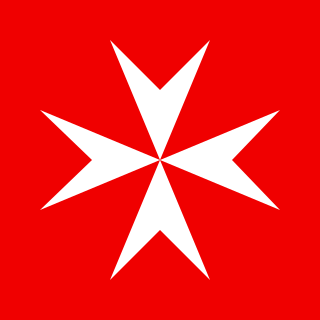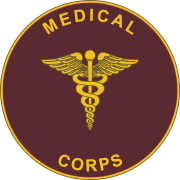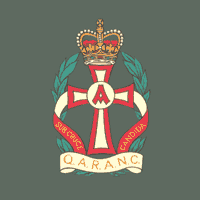
A nurse uniform is attire worn by nurses for hygiene and identification. The traditional nurse uniform consists of a dress, apron and cap. It has existed in many variants, but the basic style has remained recognizable.

Hospital volunteers, also known as candy stripers in the United States, work without regular pay in a variety of health care settings, usually under the direct supervision of nurses.

The Maltese cross is a cross symbol, consisting of four "V" or arrowhead shaped concave quadrilaterals converging at a central vertex at right angles, two tips pointing outward symmetrically.

International Nurses Day (IND) is an international day observed around the world on 12 May each year, to mark the contributions that nurses make to society.

Helen Kathleen Mussallem was a Canadian nurse, who served in the Royal Canadian Army Medical Corps during World War II.

A pinning ceremony is a symbolic welcoming of newly graduated or soon-to-be graduated nurses into the nursing profession.
St John Ambulance Ireland (SJAI), previously known as the St John Ambulance Brigade of Ireland, is a charitable voluntary organisation in Ireland. For constitutional reasons it is not a full member association of the Venerable Order of Saint John and the international St. John Ambulance movement, but rather is classed as an "associated body". The organisation is dedicated to the teaching and practice of medical first aid. It is engaged in first aid training to the public, providing first aid and ambulance cover at public events, patient transport and community services.

The Order of Malta Ireland – Ambulance Corps is a voluntary ambulance and first aid organisation operating in Ireland in affiliation with the Sovereign Military Order of Malta, founded in 1938.

Dame Alicia Frances Jane Lloyd Still, DBE, RRC, SRN (1869–1944) was a British nurse, teacher, hospital matron and leader of her profession. She was one of the leaders in the campaign for state registration of nurses. Following the Nurses Registration Act 1919, she was a member of the General Nursing Council (1920-1937). As chairwoman of the General Nursing Council's first Education and Examinations Committee she helped establish the first national examination standards for the registration of nurses.

A nurse's cap or nursing cap is part of the female nurse's uniform, introduced early in the history of the profession. The cap's original purpose was to keep the nurse's hair neatly in place and present a modest appearance. Male nurses do not wear caps.
The word "nurse" originally came from the Latin word "nutrire", meaning to suckle, referring to a wet-nurse; only in the late 16th century did it attain its modern meaning of a person who cares for the infirm.

Nursing is a profession within the healthcare sector focused on the care of individuals, families, and communities so they may attain, maintain, or recover optimal health and quality of life. Nurses may be differentiated from other healthcare providers by their approach to patient care, training, and scope of practice. Nurses practice in many specialties with differing levels of prescription authority. Nurses comprise the largest component of most healthcare environments; but there is evidence of international shortages of qualified nurses. Nurses collaborate with other healthcare providers such as physicians, nurse practitioners, physical therapists, and psychologists. There is a distinction between nurses and nurse practitioners; in the U.S., the latter are nurses with a graduate degree in advanced practice nursing, and are permitted to prescribe medications unlike the former. They practice independently in a variety of settings in more than half of the United States. Since the postwar period, nurse education has undergone a process of diversification towards advanced and specialized credentials, and many of the traditional regulations and provider roles are changing.

Scrubs are the sanitary clothing worn by physicians, nurses, dentists and other workers involved in patient care. Originally designed for use by surgeons and other operating room personnel, who would put them on when sterilizing themselves, or "scrubbing in", before surgery, they are now worn by many hospital personnel.
A self-styled order or pseudo-chivalric order is an organisation which claims to be a chivalric order, but is not recognised as legitimate by countries or international bodies. Most self-styled orders arose in or after the mid-18th century, and many have been created recently. Most are short-lived and endure no more than a few decades.
In Islam, nurses provide healthcare services to patients, families and communities as a manifestation of love for Allah and Muhammad. The nursing profession is not new to Islam. Islamic traditions include sympathy for and responsibility toward those in need. This perspective had emerged during the development of Islam as a religion, culture, and civilization.

The caduceus is the traditional symbol of Hermes and features two snakes winding around an often winged staff. It is often used as a symbol of medicine, especially in the United States, despite its ancient and consistent associations with trade, liars, thieves, eloquence, negotiation, alchemy, and wisdom.

The flag and coat of arms of the Sovereign Military Order of Malta, or the Jerusalem flag, display a white cross on a red field, ultimately derived from the design worn by the Knights Hospitaller during the Crusades.

Historically, women have made up a large majority of the profession and academic discipline of nursing. Women's nursing roles include both caring for patients and making sure that the wards and equipment are clean. In the United States, women make up the majority of the field of nursing, comprising 86% of Registered Nurses (RNs) in 2021; globally, women comprise 89% of the nursing workforce.
The New Zealand Army Nursing Service (NZANS) formally came into being in early 1915, when the Army Council in London accepted an offer of nurses to help in the war effort during the First World War from the New Zealand Government. The heavy losses experienced in the Gallipoli campaign cemented the need for the service.

Florence Church Bullard (1880–1967) was an American nurse and recipient of the French Croix de Guerre with a bronze star. Trained at St. Mary's Hospital Nursing School in Rochester, Minnesota, she served with the American Red Cross in the American Volunteer Motor Ambulance Corps.


















